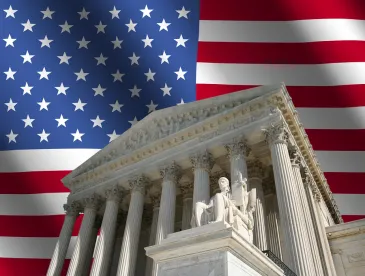The Supreme Court granted and consolidated three petitions for writs of certiorari to hear two questions regarding the constitutionality of Administrative Patent Judge (APJ) appointments under the Appointments Clause. These questions are: Whether APJs of the Patent Trial and Appeal Board (PTAB) are principal officers who must be appointed by the President under the Appointments Clause of the Constitution; and whether, if APJs are determined to be principal officers, severing the application of 5 U.S.C. 7513(a) to those judges cures any violation of the Appointments Clause. The Court declined to hear a third question of whether the Court of Appeals in the Arthrex[1] case erred by adjudicating the Appointments Clause question despite the failure of Arthrex to present its Appointments Clause challenge during the PTAB proceedings.
The three petitions before the Court sought review of the Federal Circuits judgment in Arthrex, Inc. v. Smith & Nephew, Inc., 941 F.3d 1320 (2019), or Polaris Innovations Ltd. v. Kingston Technology Co., 792 Fed. Appx. 820 (2020) (per curiam). In Arthrex, the Federal Circuit held that APJs are principal officers who must be appointed by the President, with the advice and consent of the Senate, under the Appointments Clause. Consequently, the court held that the then-current process of the Secretary of Commerce appointing APJs acting alone was unconstitutional. The Federal Circuit vacated the PTAB’s underlying Arthrex decision, remanded for a new hearing, and directed designation of a new panel of APJs to hear the PTAB proceeding. The Federal Circuit also severed the application of 5 U.S.C. 7513(a) to APJs, a provision it deemed made removal of such APJs more difficult.
The Federal Circuit decreed that its ruling and remedy would extend to all cases in which the PTAB issued a final written decision and the litigants present an Appointments Clause challenge on appeal, regardless of whether such challenge was asserted during the underlying PTAB proceedings. As a consequence, the Federal Circuit has since vacated and remanded numerous other PTAB decisions. The USPTO issued a General Order staying more than 100 proceedings pending action by the Supreme Court.
The Supreme Court’s decision on the Federal Circuit’s conclusion could have far-reaching consequences for patent owners, patent challengers, the USPTO and the PTAB. As it stands, the Federal Circuit struck down as unconstitutional that portion of the statutory framework that made APJs difficult to remove. The Supreme Court could determine that the original statutory framework did not present an Appointments Clause issue, returning the status quo. Alternatively, the Court could agree with the Federal Circuit’s decision in Arthrex, potentially resulting in the rehearing of numerous PTAB trials, or it could conceivably determine that other portions of the relevant statutory framework are unconstitutional. Because the PTAB proceedings have been a valuable and widely used tool for efficiently resolving validity issues with granted US patents, this case will be closely watched by many.
FOOTNOTES
[1] Arthrex, Inc. v. Smith & Nephew, Inc., 941 F.3d 1320 (2019)



 />i
/>i
